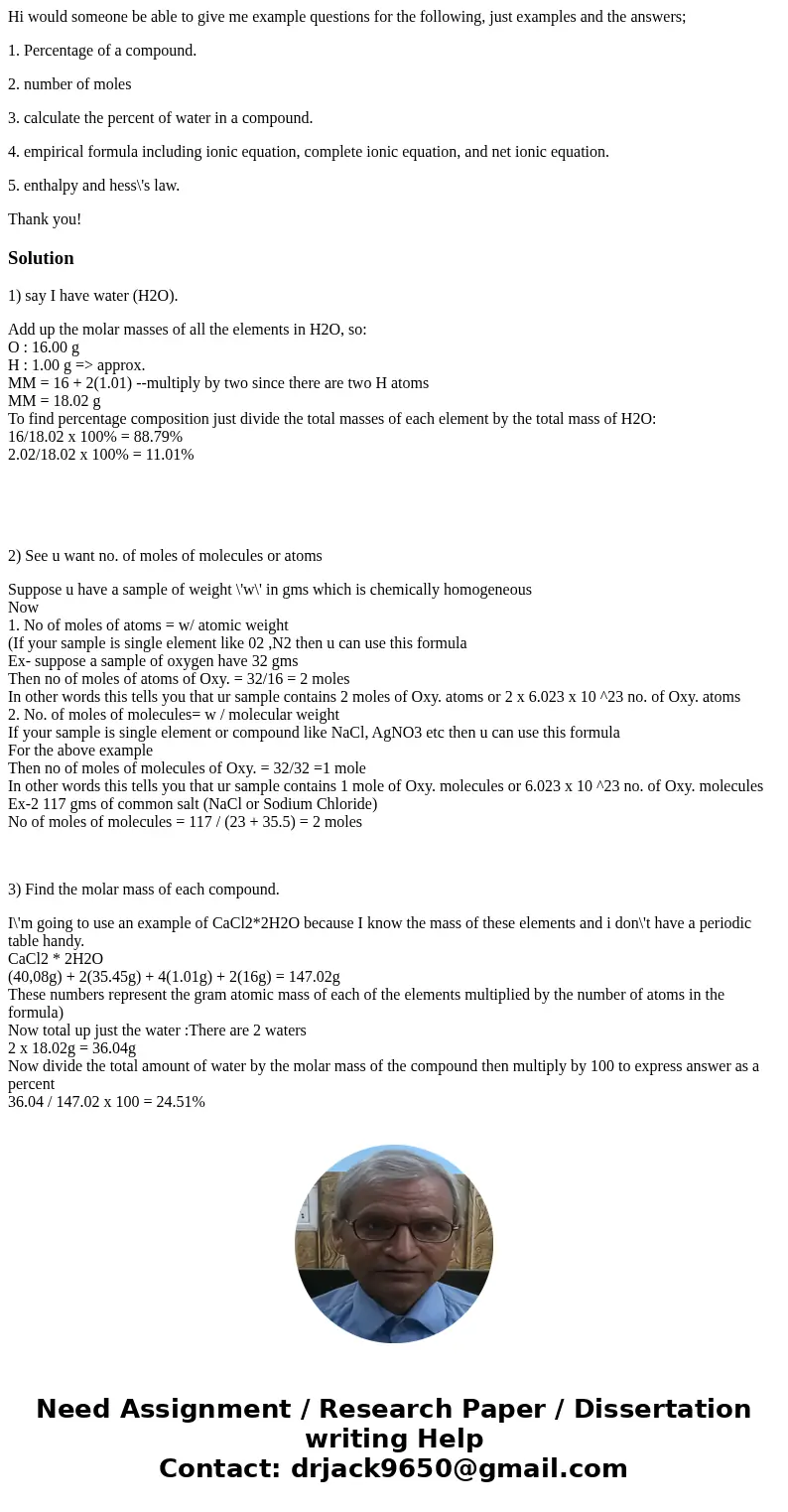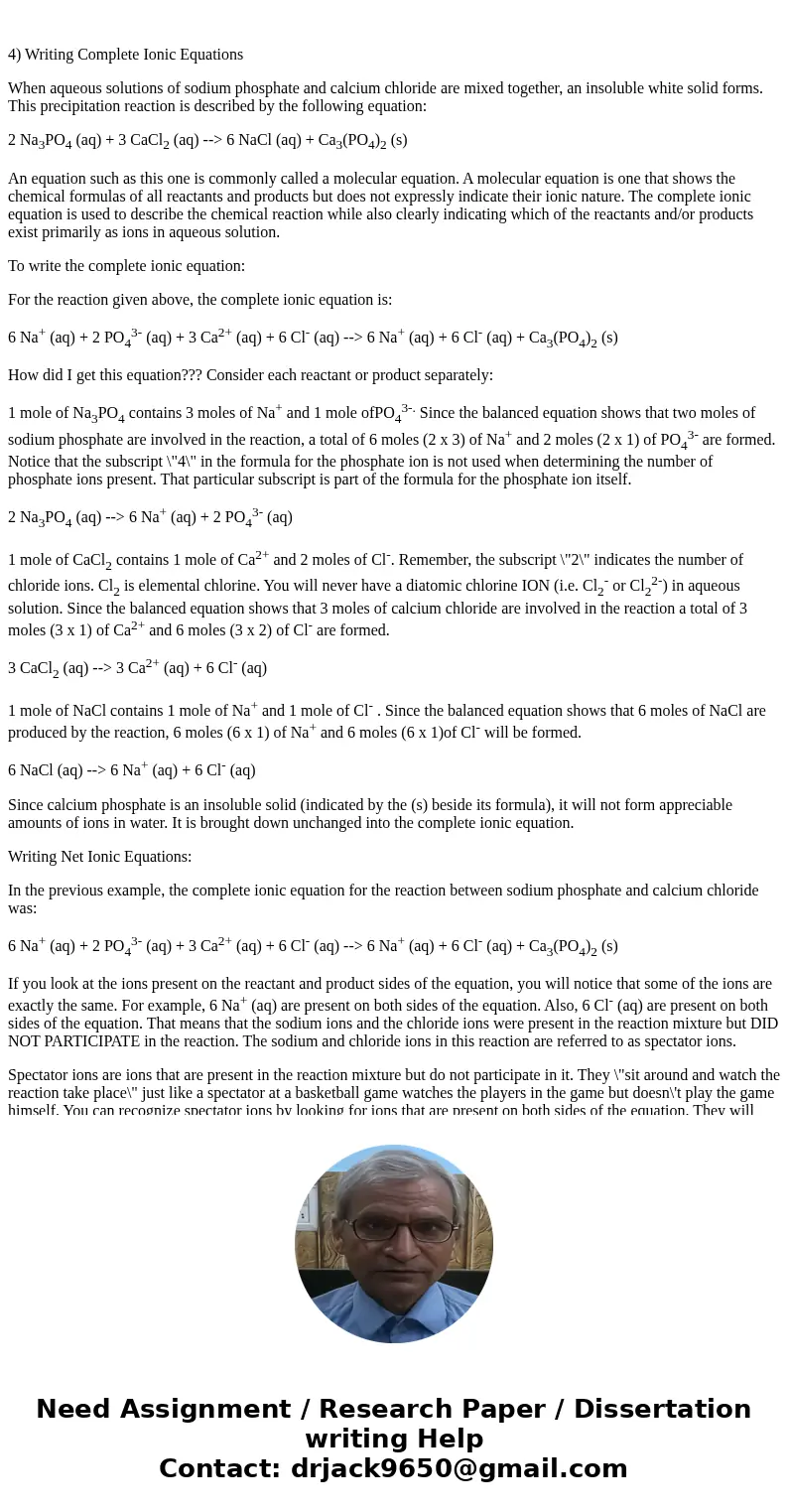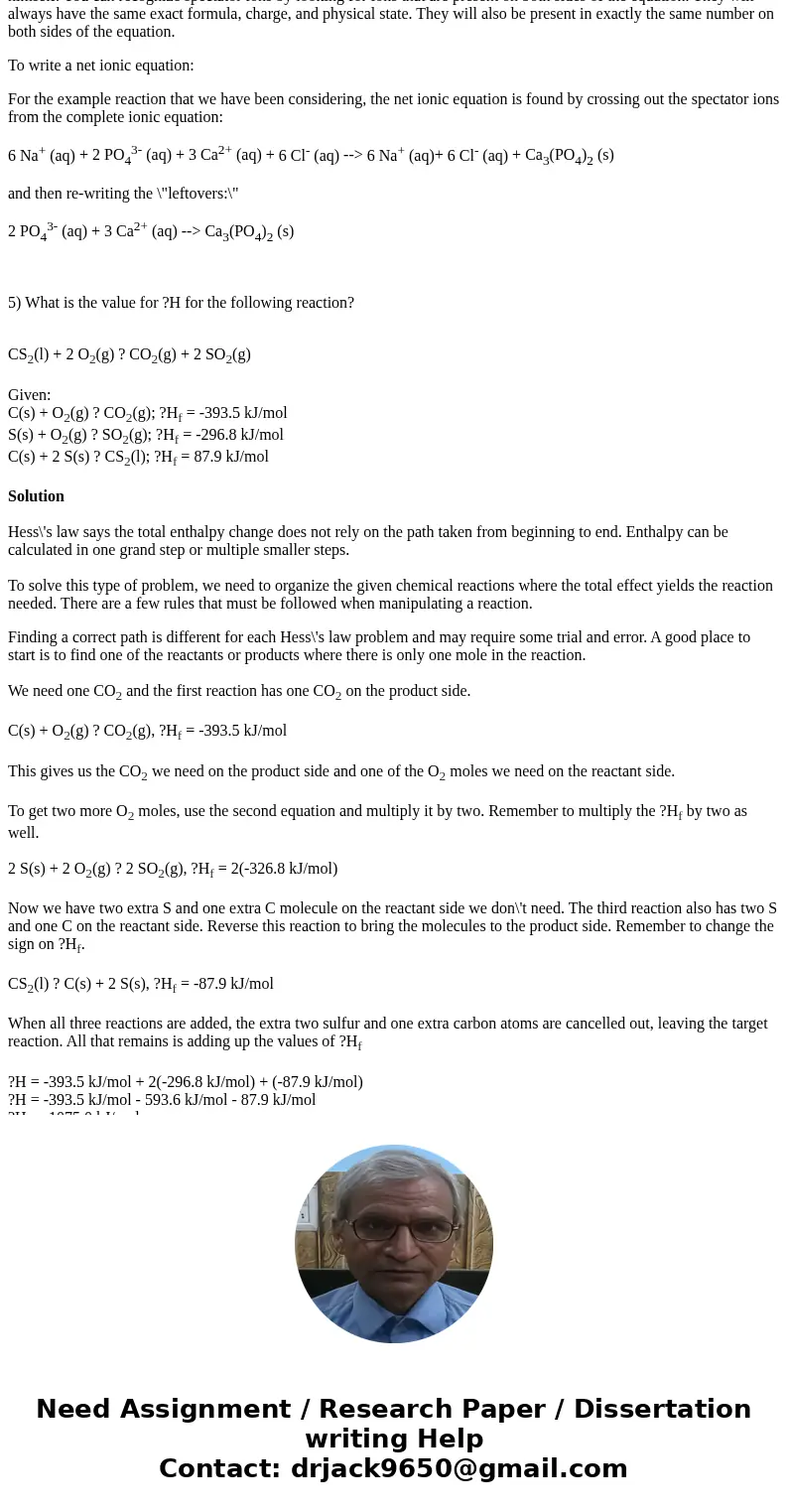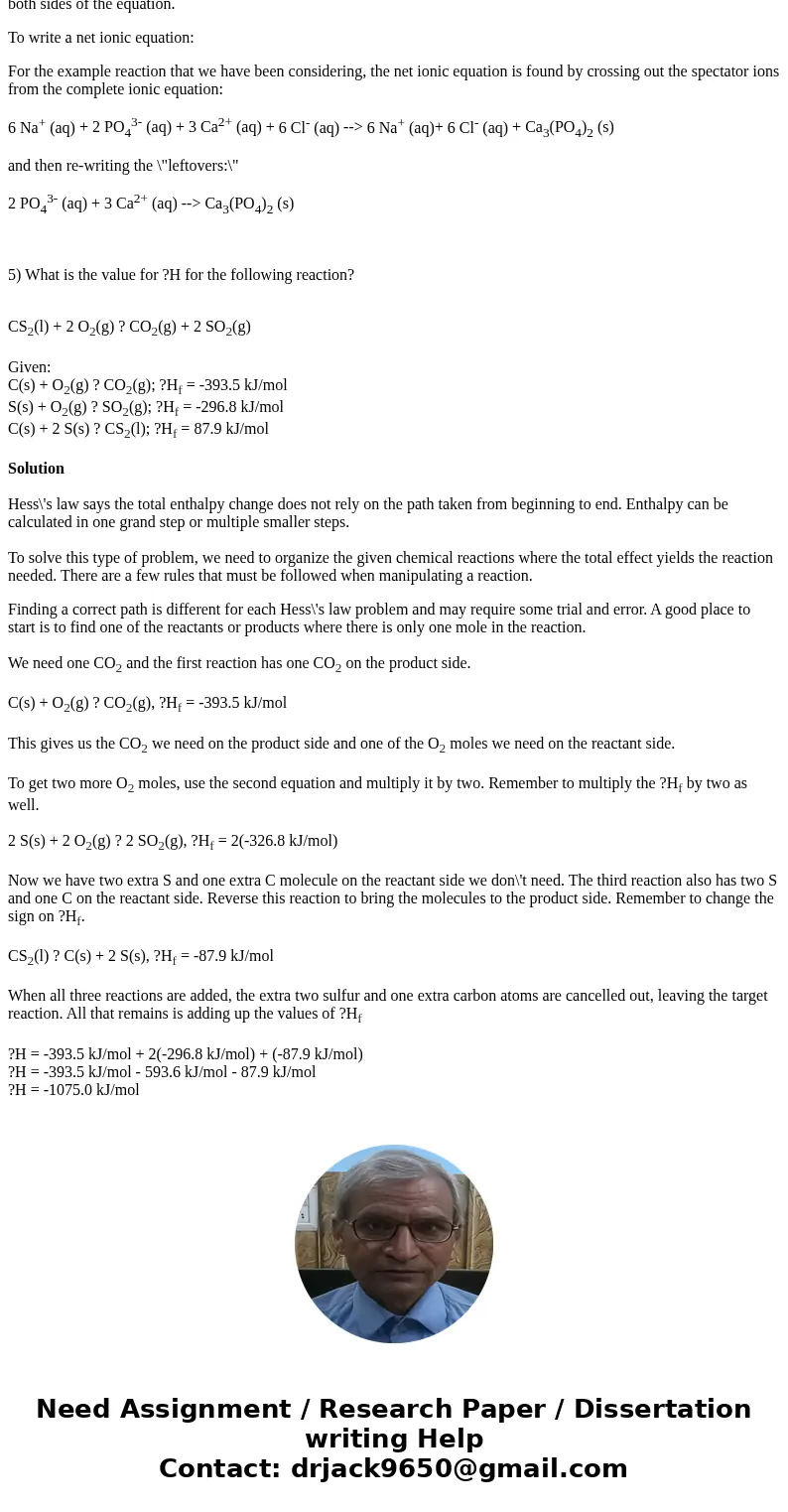Hi would someone be able to give me example questions for th
Hi would someone be able to give me example questions for the following, just examples and the answers;
1. Percentage of a compound.
2. number of moles
3. calculate the percent of water in a compound.
4. empirical formula including ionic equation, complete ionic equation, and net ionic equation.
5. enthalpy and hess\'s law.
Thank you!
Solution
1) say I have water (H2O).
Add up the molar masses of all the elements in H2O, so:
O : 16.00 g
H : 1.00 g => approx.
MM = 16 + 2(1.01) --multiply by two since there are two H atoms
MM = 18.02 g
To find percentage composition just divide the total masses of each element by the total mass of H2O:
16/18.02 x 100% = 88.79%
2.02/18.02 x 100% = 11.01%
2) See u want no. of moles of molecules or atoms
Suppose u have a sample of weight \'w\' in gms which is chemically homogeneous
Now
1. No of moles of atoms = w/ atomic weight
(If your sample is single element like 02 ,N2 then u can use this formula
Ex- suppose a sample of oxygen have 32 gms
Then no of moles of atoms of Oxy. = 32/16 = 2 moles
In other words this tells you that ur sample contains 2 moles of Oxy. atoms or 2 x 6.023 x 10 ^23 no. of Oxy. atoms
2. No. of moles of molecules= w / molecular weight
If your sample is single element or compound like NaCl, AgNO3 etc then u can use this formula
For the above example
Then no of moles of molecules of Oxy. = 32/32 =1 mole
In other words this tells you that ur sample contains 1 mole of Oxy. molecules or 6.023 x 10 ^23 no. of Oxy. molecules
Ex-2 117 gms of common salt (NaCl or Sodium Chloride)
No of moles of molecules = 117 / (23 + 35.5) = 2 moles
3) Find the molar mass of each compound.
I\'m going to use an example of CaCl2*2H2O because I know the mass of these elements and i don\'t have a periodic table handy.
CaCl2 * 2H2O
(40,08g) + 2(35.45g) + 4(1.01g) + 2(16g) = 147.02g
These numbers represent the gram atomic mass of each of the elements multiplied by the number of atoms in the formula)
Now total up just the water :There are 2 waters
2 x 18.02g = 36.04g
Now divide the total amount of water by the molar mass of the compound then multiply by 100 to express answer as a percent
36.04 / 147.02 x 100 = 24.51%
4) Writing Complete Ionic Equations
When aqueous solutions of sodium phosphate and calcium chloride are mixed together, an insoluble white solid forms. This precipitation reaction is described by the following equation:
2 Na3PO4 (aq) + 3 CaCl2 (aq) --> 6 NaCl (aq) + Ca3(PO4)2 (s)
An equation such as this one is commonly called a molecular equation. A molecular equation is one that shows the chemical formulas of all reactants and products but does not expressly indicate their ionic nature. The complete ionic equation is used to describe the chemical reaction while also clearly indicating which of the reactants and/or products exist primarily as ions in aqueous solution.
To write the complete ionic equation:
For the reaction given above, the complete ionic equation is:
6 Na+ (aq) + 2 PO43- (aq) + 3 Ca2+ (aq) + 6 Cl- (aq) --> 6 Na+ (aq) + 6 Cl- (aq) + Ca3(PO4)2 (s)
How did I get this equation??? Consider each reactant or product separately:
1 mole of Na3PO4 contains 3 moles of Na+ and 1 mole ofPO43-. Since the balanced equation shows that two moles of sodium phosphate are involved in the reaction, a total of 6 moles (2 x 3) of Na+ and 2 moles (2 x 1) of PO43- are formed. Notice that the subscript \"4\" in the formula for the phosphate ion is not used when determining the number of phosphate ions present. That particular subscript is part of the formula for the phosphate ion itself.
2 Na3PO4 (aq) --> 6 Na+ (aq) + 2 PO43- (aq)
1 mole of CaCl2 contains 1 mole of Ca2+ and 2 moles of Cl-. Remember, the subscript \"2\" indicates the number of chloride ions. Cl2 is elemental chlorine. You will never have a diatomic chlorine ION (i.e. Cl2- or Cl22-) in aqueous solution. Since the balanced equation shows that 3 moles of calcium chloride are involved in the reaction a total of 3 moles (3 x 1) of Ca2+ and 6 moles (3 x 2) of Cl- are formed.
3 CaCl2 (aq) --> 3 Ca2+ (aq) + 6 Cl- (aq)
1 mole of NaCl contains 1 mole of Na+ and 1 mole of Cl- . Since the balanced equation shows that 6 moles of NaCl are produced by the reaction, 6 moles (6 x 1) of Na+ and 6 moles (6 x 1)of Cl- will be formed.
6 NaCl (aq) --> 6 Na+ (aq) + 6 Cl- (aq)
Since calcium phosphate is an insoluble solid (indicated by the (s) beside its formula), it will not form appreciable amounts of ions in water. It is brought down unchanged into the complete ionic equation.
Writing Net Ionic Equations:
In the previous example, the complete ionic equation for the reaction between sodium phosphate and calcium chloride was:
6 Na+ (aq) + 2 PO43- (aq) + 3 Ca2+ (aq) + 6 Cl- (aq) --> 6 Na+ (aq) + 6 Cl- (aq) + Ca3(PO4)2 (s)
If you look at the ions present on the reactant and product sides of the equation, you will notice that some of the ions are exactly the same. For example, 6 Na+ (aq) are present on both sides of the equation. Also, 6 Cl- (aq) are present on both sides of the equation. That means that the sodium ions and the chloride ions were present in the reaction mixture but DID NOT PARTICIPATE in the reaction. The sodium and chloride ions in this reaction are referred to as spectator ions.
Spectator ions are ions that are present in the reaction mixture but do not participate in it. They \"sit around and watch the reaction take place\" just like a spectator at a basketball game watches the players in the game but doesn\'t play the game himself. You can recognize spectator ions by looking for ions that are present on both sides of the equation. They will always have the same exact formula, charge, and physical state. They will also be present in exactly the same number on both sides of the equation.
To write a net ionic equation:
For the example reaction that we have been considering, the net ionic equation is found by crossing out the spectator ions from the complete ionic equation:
6 Na+ (aq) + 2 PO43- (aq) + 3 Ca2+ (aq) + 6 Cl- (aq) --> 6 Na+ (aq)+ 6 Cl- (aq) + Ca3(PO4)2 (s)
and then re-writing the \"leftovers:\"
2 PO43- (aq) + 3 Ca2+ (aq) --> Ca3(PO4)2 (s)
5) What is the value for ?H for the following reaction?
CS2(l) + 2 O2(g) ? CO2(g) + 2 SO2(g)
Given:
C(s) + O2(g) ? CO2(g); ?Hf = -393.5 kJ/mol
S(s) + O2(g) ? SO2(g); ?Hf = -296.8 kJ/mol
C(s) + 2 S(s) ? CS2(l); ?Hf = 87.9 kJ/mol
Solution
Hess\'s law says the total enthalpy change does not rely on the path taken from beginning to end. Enthalpy can be calculated in one grand step or multiple smaller steps.
To solve this type of problem, we need to organize the given chemical reactions where the total effect yields the reaction needed. There are a few rules that must be followed when manipulating a reaction.
Finding a correct path is different for each Hess\'s law problem and may require some trial and error. A good place to start is to find one of the reactants or products where there is only one mole in the reaction.
We need one CO2 and the first reaction has one CO2 on the product side.
C(s) + O2(g) ? CO2(g), ?Hf = -393.5 kJ/mol
This gives us the CO2 we need on the product side and one of the O2 moles we need on the reactant side.
To get two more O2 moles, use the second equation and multiply it by two. Remember to multiply the ?Hf by two as well.
2 S(s) + 2 O2(g) ? 2 SO2(g), ?Hf = 2(-326.8 kJ/mol)
Now we have two extra S and one extra C molecule on the reactant side we don\'t need. The third reaction also has two S and one C on the reactant side. Reverse this reaction to bring the molecules to the product side. Remember to change the sign on ?Hf.
CS2(l) ? C(s) + 2 S(s), ?Hf = -87.9 kJ/mol
When all three reactions are added, the extra two sulfur and one extra carbon atoms are cancelled out, leaving the target reaction. All that remains is adding up the values of ?Hf
?H = -393.5 kJ/mol + 2(-296.8 kJ/mol) + (-87.9 kJ/mol)
?H = -393.5 kJ/mol - 593.6 kJ/mol - 87.9 kJ/mol
?H = -1075.0 kJ/mol




 Homework Sourse
Homework Sourse